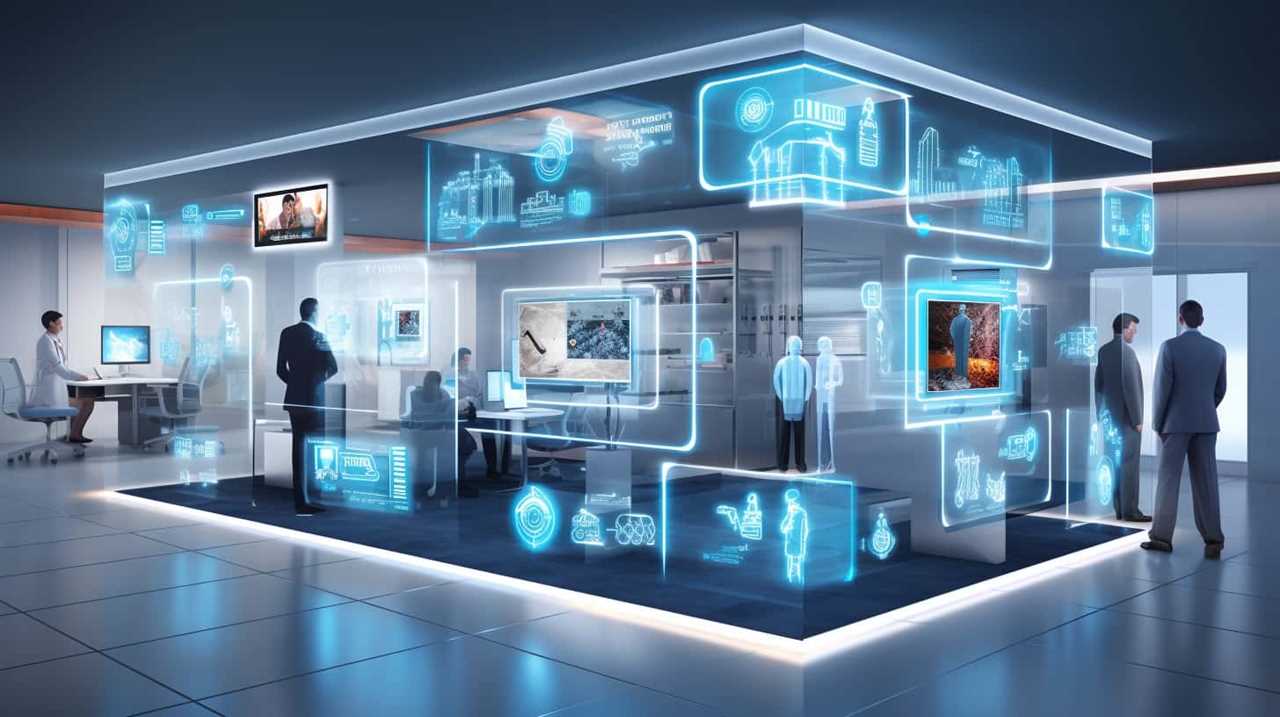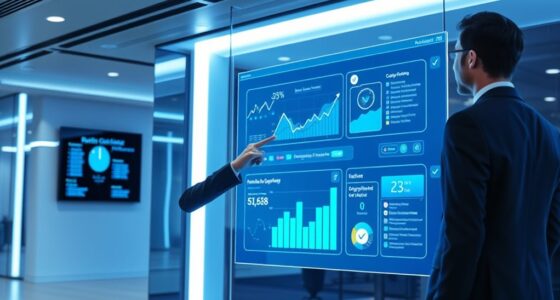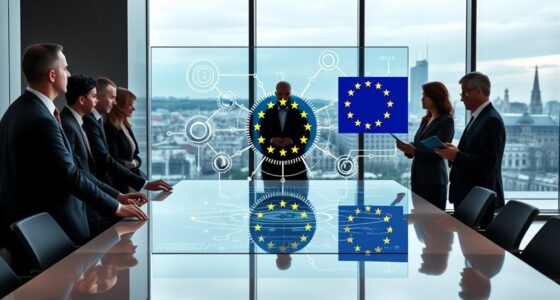When it comes to generative AI and copyright, you need to understand that AI-created works can raise complex legal questions. Typically, copyright protection requires human authorship, so works solely generated by AI might not qualify. Licensing agreements help define how these creations can be used or shared. As laws are still evolving, staying informed about legal rulings and best practices helps protect your rights and avoids disputes. You’ll find more details ahead.
Key Takeaways
- Generative AI raises questions about copyright ownership of AI-created works and whether they qualify for protection.
- Licensing agreements clarify rights to use, modify, and distribute AI-generated content, preventing legal disputes.
- Copyright law struggles to address authorship and originality when AI significantly contributes to creative outputs.
- Clear licensing and documentation are essential to establish rights and protect AI-generated intellectual property.
- Legal developments are ongoing to define protections and standards for copyrights involving generative AI technologies.

Artificial intelligence is transforming how we create and protect intellectual property, raising new questions about ownership and originality. As AI-generated works become more common, you need to understand how this impacts your rights and protections. One critical aspect is AI licensing, which involves the legal agreements that allow others to use your AI models or outputs. When you develop an AI system capable of creating content, licensing it properly ensures you retain control over how it’s used, especially as your technology gains commercial value. Licensing agreements also clarify whether users can modify, distribute, or commercialize AI-generated works, which is crucial in avoiding legal disputes. As AI’s role in generating creative outputs grows, establishing clear licensing terms becomes essential to protect your interests and monetize your innovations effectively. Additionally, the evolving legal landscape around AI necessitates staying informed about new rulings and standards to safeguard your rights.
Another key concern is patent protection. Traditionally, patents safeguard inventions that are novel, non-obvious, and useful. However, when AI is involved in creating or improving inventions, questions arise about whether AI can be listed as an inventor or if the patent should be granted solely to the human developers or owners. If you’ve developed an AI-driven process or device, securing patent protection can be more complex but equally important. You’ll need to demonstrate that your AI invention meets patent criteria and clearly define the scope of your claims to prevent infringement or unauthorized use. Patent offices around the world are still grappling with how to handle AI-generated inventions, which means you must stay informed and adapt your patent strategies accordingly. Proper patent protection not only secures your competitive advantage but also helps you defend against potential patent infringements.
Understanding these aspects of AI licensing and patent protection is essential as you navigate the evolving landscape of intellectual property. You must guarantee that your rights are well-defined when licensing AI technology, avoiding ambiguity that could undermine your control or revenue. Simultaneously, securing patent protection for AI innovations demands careful documentation and strategic filing to establish clear ownership rights. As AI continues to blur traditional lines of authorship and inventorship, staying proactive is your best defense. You’ll want to work with legal experts who understand the nuances of AI-related IP law, ensuring your creations are protected and your licensing agreements are airtight. This way, you can harness AI’s potential while safeguarding your innovations against infringement and unauthorized use, ultimately strengthening your position in an increasingly AI-driven economy.
Frequently Asked Questions
How Does Ai-Generated Content Impact Traditional Copyright Laws?
You might find that AI-generated content challenges traditional copyright laws by blurring the lines of creative authorship. When algorithms produce work, questions about algorithm ownership arise, making it unclear who holds rights. This impacts how copyright applies, as it’s traditionally tied to human creators. You need to ponder whether AI acts as a tool or a co-creator, affecting legal protections and rights distribution in creative works.
Who Owns the Rights to Ai-Created Works?
You might wonder who owns the rights to AI-created works. The truth is, authorship attribution isn’t straightforward. Typically, rights ownership depends on who controls the AI and inputs the creative direction. If you’re the creator or operator, you likely hold the rights, but it can get complicated, especially with collaborative efforts. Stay alert—these evolving rules mean your ownership could change as laws adapt to AI’s rise.
Can AI Algorithms Infringe on Existing Copyrights?
Yes, AI algorithms can infringe on existing copyrights if they use protected works without permission. To prevent this, you should prioritize AI ethics and make sure algorithms are transparent about their training data. By understanding how your AI models operate and respecting copyright laws, you reduce the risk of infringement. Transparency helps you identify potential issues early, fostering responsible AI development and safeguarding intellectual property rights.
What Legal Protections Exist for Ai-Generated Inventions?
You might find that legal protections for AI-generated inventions are limited, as currently, AI isn’t recognized as a legal person. This means AI can’t hold patents, and inventions typically require human inventors for patent eligibility. Some jurisdictions are exploring legal personhood, which could grant AI more rights in the future, but, for now, you should focus on human involvement to secure patent protections for your AI-assisted inventions.
How Are International Copyright Laws Adapting to AI Advancements?
International copyright laws are evolving like a river carving new paths, adapting to AI’s rapid currents. You’ll see treaty adaptations that aim to bridge cross-border enforcement challenges, creating a safety net for digital creations. Countries are working together to update agreements, ensuring AI-generated works are protected worldwide. This global dance seeks to harmonize rules, so creators like you can navigate AI’s vast landscape with confidence and clarity.
Conclusion
As you navigate the evolving landscape of AI and intellectual property, remember that these gray areas invite careful thought and gentle adaptation. While challenges arise, they also open doors to new opportunities and innovative solutions. Embrace the dialogue, let collaboration guide your steps, and stay mindful of the delicate balance between creation and protection. With thoughtful approaches, you can help shape a future where technology and rights coexist harmoniously, fostering growth without undue concern.









